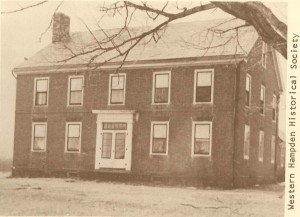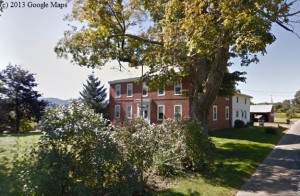 by JEANETTE FLECK
by JEANETTE FLECK
WSU Intern
In 1755 – 20 years before the start of the Revolutionary War, but nearly 80 after the Massachusetts government recognized the town of Westfield – Captain John Bancroft built a house on his farm. The event, at the time, might not have seemed remarkable, but for two things. First, the house was made of brick, making it the first brick house built in Westfield, and the second built in what would become Hampden County. Second, in 2014, nearly 260 years later, Bancroft’s brick house is still standing.
Born in April 1722, Bancroft was a wealthy, slave-owning farmer who was awarded the rank of captain during the French and Indian War. He owned most of the land in the region that is now Pochassic Road, and it’s unclear if he and his wife, Mercy, had any children. His largest claim to fame, though, is his alignment during the Revolutionary War. Unlike General Shepard, who gained his fame fighting under George Washington, Bancroft’s name became infamous, appearing in September 1776 on a list, published in Connecticut, of “persons held up to public view as enemies of their country.”

Bancroft’s name was placed on that list for granting hospitality to one Captain McKay, a British officer painted as a brute by the patriot press. McKay had escaped from capture in Hartford, and was heading north to Quebec, “there to join the Ministerial butchers, to cut the throats of our brethren in Canada,” as one committee phrased his offense on June 20, 1776. That same committee ordered Bancroft to house arrest for aiding the Patriots’ one-time prisoner and current enemy. During the 1800’s, after the Revolution, more information was released, revealing that Bancroft had also sold secrets to the British throughout the revolution. A short volume on Captain Bancroft, titled Westfield’s Foremost Tory, is available for research purposes at the Westfield Athenaeum.
Bancroft eventually regained some of his status in Westfield, though it is unclear whether or not he regained it before his death in 1793. The house just continued its existence, which has always been residential, and part of a farm. For most of the 1900s, it was owned by the Stevens family, though it changed hands in the 1980s. The Sorel family, of Bill’s Truck and Equipment Repair, has lived there for the last thirty years.
Kimberly Sorel, one of the current residents, describes the ways that her family tries to keep the interior of the house as close to the original as possible: the shutters still hang on the inside, next to the windows, the kitchen still contains its original beehive brick oven, and there are even still some old chests in the attic. In addition, the north side of the house’s exterior still has its original slate roof. Sorel also notes the large hallways and wide staircase, which make the house’s interior seem spacious. When asked how she feels about living in such an old house, she simply says she has enjoyed it. The atmosphere inside it emphasizes just how long it has been standing. The house, according to Sorel, “has its own life.”

